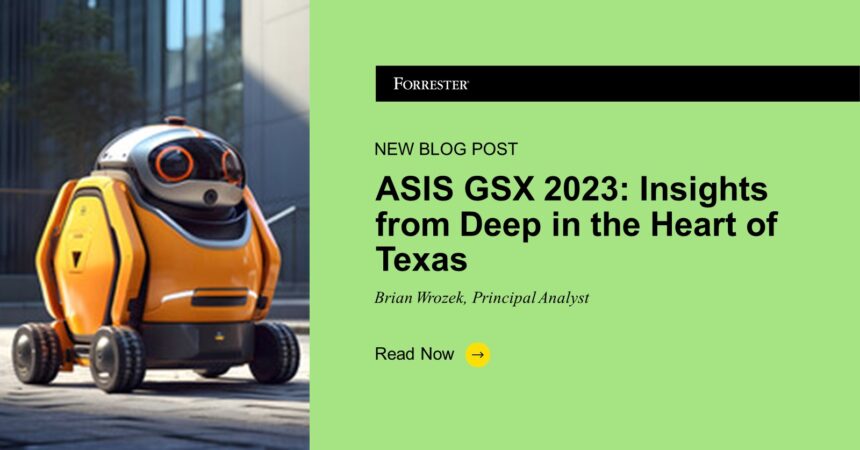ASIS International, the largest membership organization for security management professionals, brought the 2023 Global Security Exchange (GSX) to my hometown of Dallas, Texas. The main attraction of this premier physical security event was the keynote delivered by the 43rd President of the United States, George W Bush. The five-day event provided ample networking opportunities, 200+ educational sessions organized into Crime, Risk Management, and Operational Security tracks, and 400+ different exhibitors.
During the week, I networked with corporate security professionals, law enforcement, emergency fire and medical personnel, members of the military, and even fellow cybersecurity geeks.
The exhibit hall experience was more than just collecting brochures and watching vendor product demos. You could see operational parking lot gates and turnstile access control equipment. You could walk through weapon detection sensors that identify concealed weapons or enter a safe room. You could examine the latest locking mechanisms, perimeter fencing materials, bullet proof glass, and drone detection radar systems.
Here are my top five take-aways from GSX:
- Change: The physical security industry is rapidly changing. Post pandemic working from home models have altered the relationship between organizational security and employees. The General Duty Clause (Section 5) of the OSHA Act of 1970 requires employers to provide a safe and healthy work environment for their employees even if they work remotely but what that means is still being debated. Employers must extend their workplace violence prevention programs and adapt their behavioral threat assessments to remote workers or risk exposing the company to liability. Travel risk management solutions are expanding as business travel increases and employees must deal with weather, political instability, crime, and other risks while traveling.
- Robots: Robots were the stars of the exhibit hall. Robots are being used to perform various tasks such as monitoring parking lots or warehouses. The ability to move to areas of interest and interact with the physical world makes robots preferable to statically positioned cameras. Robots can go into areas dangerous to humans and while they never get tired or distracted, they enable and elevate human performance, not replace it. I admit that the robot designed to look like a dog was a bit of a shock, but it didn’t take long until I warmed up to the little guy. While it has video and audio capabilities, other IoT sensors can be added to expand functionality. The dog form factor can also operate on uneven terrain. Cultural acceptance of robots is still the current biggest obstacle to adoption, and we can expect regulatory constraints to limit where, when, and how robots are used.
- Digital Revolution: Historically, physical security professionals were less willing to experiment with cutting edge technologies, preferring safe, proven approaches to protect employees and facilities. While most physical security deployments remain on-premises or in the case of robots, on-board cloud options are emerging as a viable alternative. Digital twins of facilities promote realistic simulations with 3D visualization and spatial models to aid in risk assessments, planning, and training. This saves costs associated with performing the security work in-person and minimizes disruptions to operations. The adoption of new technologies to address physical security requirements is accelerating as more of the profession becomes digital and IT and cybersecurity capture larger portions of the overall security budget.
- Artificial Intelligence (AI): AI is revolutionizing physical security. AI is powering advancements in weapons and explosive materials detection, robotics, and risk intelligence. Video surveillance cameras are no longer just recording devices. They are smart edge technologies that can perform sophisticated object analysis like differentiating a backpack from a purse, identifying the color of clothing, and recognize actions like running or falling. Investigators can search for these data tags or proactively alert on a specific condition rather than manually watching endless video streams. Another interesting use case is using existing optical fiber cables to collect acoustic signals and applying AI to detect activities like a person trying to climb or dig under a fence and to recognize gunfire or calls for help in an office hallway. These solutions provide adjudication across other sensors.
- Skill Gaps: Despite digital transformation and advancements in robotics, human security professionals will always play a critical role in physical security. Much has been publicized about the lack of cybersecurity talent, but physical security positions require skilled and dedicated resources that are becoming harder to find. In addition to training and certification opportunities, ASIS has been actively working multiple DEI Initiatives to make the profession more equitable and accessible to everyone. As work becomes digital, it should open new opportunities for non-traditional paths to physical security roles. Attendees remarked that collaboration between physical and cyber security teams has increased now but the actual convergence of both disciplines is still rare.
Schedule an inquiry or guidance session with me if you wish to discuss these physical security trends in more detail.








